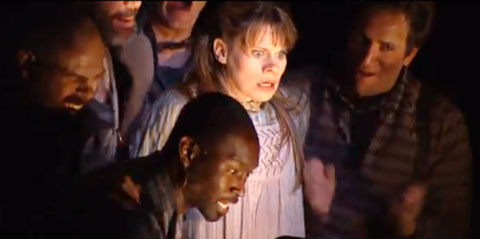Peter and the Starcatcher: An evening of complacent children’s theater
By Robert Fowler
6 September 2012
At the Brooks Atkinson Theater, New York City
Based on the children’s book by Dave Barry and Ridley Pearson, Peter and the Starcatcher was adapted for the stage by Rick Elice and made its Broadway debut in April, following a highly touted off-Broadway run at the New York Theatre Workshop in 2011. The piece has met with wide critical acclaim and was the winner of five Tony awards.
 Peter and the Starcatcher
Peter and the StarcatcherA precursor to the well-known story of Peter Pan, the plot centers on an angry orphaned boy (Adam Chanler-Berat) and his new-found friend Molly (Cecilia Keenan-Bolger), the strong-willed teenage daughter of the famous “starcatcher” (someone gifted with considerable powers), Lord Aster.
Together, Molly and Peter try to free themselves from a motley crew of grotesque pirates in an English port, and embark on a magical topsy-turvy journey across the sea that leads them to the mysterious island of Mollusk. Here, they encounter yet more grotesque individuals who enslave them.
Also aboard the H.M.S. Neverland is a trunk that apparently holds a great treasure. This chest travels with Peter and Molly through stormy seas and several epic battles before landing on the aforementioned island, where it is naturally the focus of great interest from the play’s villainous characters. Along the way, an adolescent love blossoms between Peter and Molly.
Peter and the Starcatcher is generally conventional and unexciting, for which its creators bear primarily responsibility. The performers are not able to overcome the play’s fundamental failings. In some cases, their efforts serve to emphasize those flaws.
For example, Keenan-Bolger portrays a Molly in a one-dimensional manner. She represents the girl as a snotty-nosed English brat, in a performance that never moves out of second gear. Chanler-Berat does not fare much better. His Peter is brooding and lifeless, rarely suggestive of a boy who is never going to grow up. Unhappily, the lack of chemistry between the two lead performers sets the tone for the evening.
Co-directed by Alex Timbers and the remarkable Welsh actor Roger Rees, the show is not, however, entirely without merit. The ensemble cast portrays more than a hundred different characters in a sometimes imaginative manner. Most notable is the lively performance of Matthew Saldivar as Black Stache. Indeed, Saldivar for the most part steals the show with his comic turn as the pirate destined to become Captain Hook.
In classic pantomime style, the evil Black Stache consistently addresses the audience directly as to the miseries he intends to inflict on Peter and Molly, as he and his cohorts rigorously pursue the treasure. This pursuit eventually results in a mildly amusing scene in which Black Stache inadvertently gets one of his arms caught in the treasure box. Somewhat predictably, when Black Stache frees himself he does so as the notorious one-handed buccaneer.
Saldivar manfully delivers the weak one-liners and malapropisms provided him by playwright Elice. For example: “No man is an oleaginous.” He also cleverly executes a gag in which he mixes up the meaning of the term “starcatcher.” However, such moments are rare.
Other noteworthy performances include Arnie Burton in a somewhat over-the-top effort as Molly’s fastidious nanny, Mrs. Bumbrake. Condescension and caricature are recurring issues in this production.
In long-running shows, the actors often reach a point where they simply appear to be going through the motions. In this reviewer’s opinion, the cast of Peter and the Starcatcher seems to be suffering from this condition. A limited and generally facetious script does little to help them. Nor does bland direction from Rees and Timbers.
One is struck by the general laziness of the staging. At one point, for instance, an actor tells the audience, “I want you to imagine a cat flying through the air.” Thereupon, another member of the ensemble waves a puppet over his head, moving “the cat” from stage left to stage right. The children in attendance were certainly not amused. Nor were the adults, for that matter.
Playwright Elice resorts to various cheap jokes and gags, which also largely left the audience unamused. Moreover, English jingoism is thrown unpleasantly into the mix. Elice would probably argue that he is being ironic, but the patriotic dialogue seems disturbingly heartfelt in a number of cases.
And this leads to a more serious issue: casual racism isn’t something you wouldn’t expect to encounter in theater aimed at children. Sadly, that is what we are subjected to when we arrive on the island of Mollusk.
Here we are introduced to Fighting Prawn, earnestly portrayed by Teddy Bergman, the chief of the Mollusk tribe. We rapidly discover he has a hatred of everything English, which leads him into a conflict with Peter, Molly and the pirates. The role of Prawn is poorly and insensitively written. He speaks in broken English and bumbles around the stage, like a dolt bound to come out on the losing end. Toward the end of the play, in a mawkish and contrived manner, Elice has Prawn mend his differences with Peter and Molly after the former saves his life. Such thoughtless, unchallenging writing epitomizes the piece as a whole.
If Elice, Timbers, Rees and the show’s producers think they are inspiring and educating young people with such cynical theater, they are mistaken.





Follow the WSWS